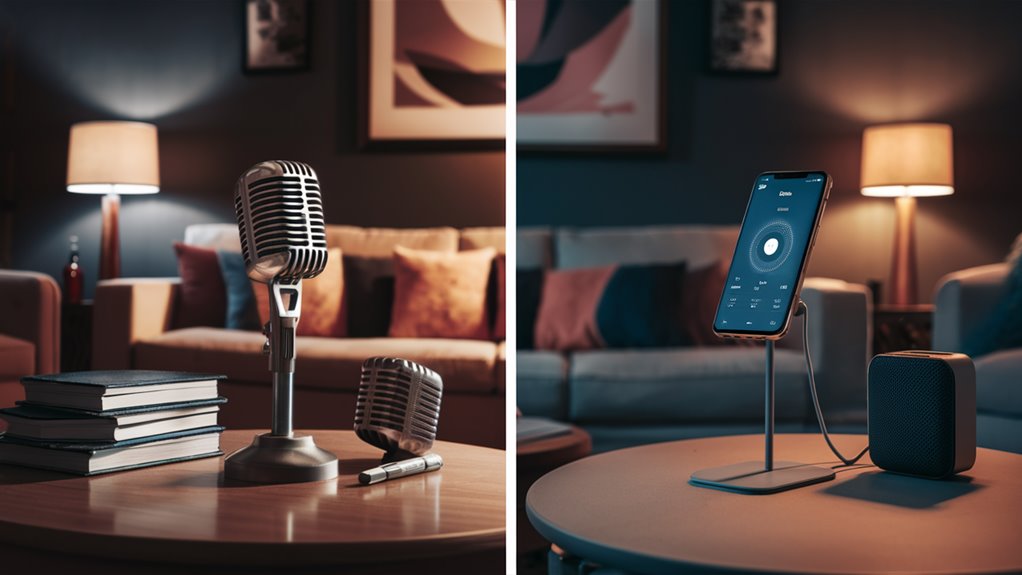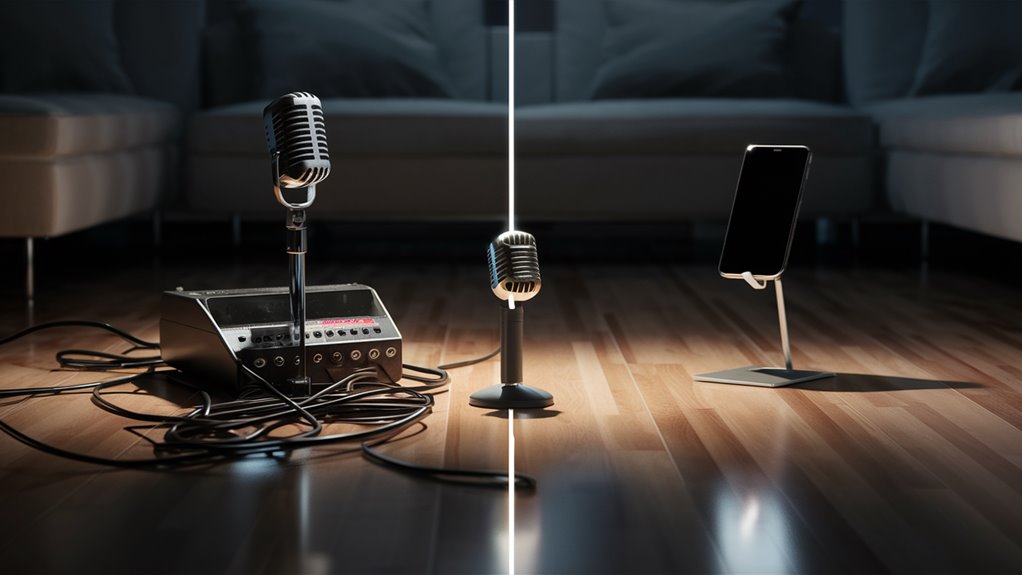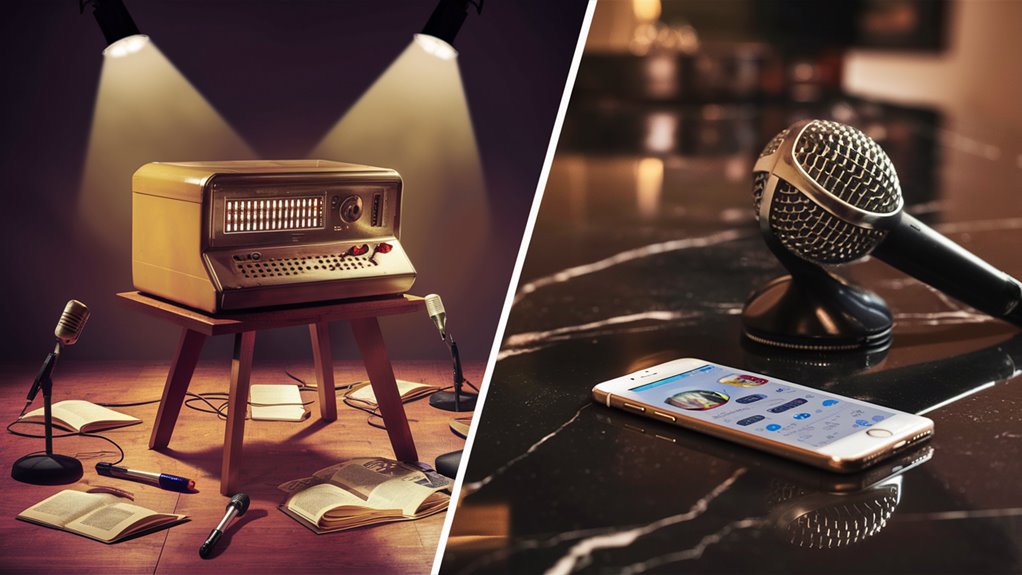Karaoke Machines vs. Karaoke Apps: Which Is Best for You?

When you look at karaoke machines and karaoke apps, you see they differ a lot in tech, sound, and how they feel to use. Professional karaoke machines have great sound quality, with top sound clarity over 90dB and sharp digital sound work. Yet, mobile karaoke apps usually get about 70dB.
Sound Work and Device Needs
Big karaoke systems can cost a lot, from $200 to more than $2000, but they give you high-level sound work and very low lag time of less than 20ms. On the other hand, karaoke apps have more lag, from 50-100ms, which might mess with live singing.
Music Choices and How Easy To Use
Mobile karaoke software wins in how many songs it offers, with lists of over 50,000 tracks and quick access to new music. But, they don’t give the multi-mic use and high sound quality that big karaoke devices do.
Picking What’s Right for You
Your choice between karaoke machines and karaoke apps depends on what’s important to you:
- Pick karaoke machines for top sound and high-level singing
- Go for karaoke apps if you want lots of songs and ease of use
Sound Quality: Karaoke Machines vs Phone Apps
Device Sound Work
Special karaoke machines beat phone apps in sound quality, because of their focused DSP chips and made-for-the-job sound design.
Tests show that big karaoke gear often gives clearer voice parts and more true pitch than phone options.
Checking the Tech
Top-end karaoke setups run with the best tech rules, like:
- 24-bit over usual 16-bit phone sound
- 96kHz rates over usual 44.1kHz in phones How to Get the Best Deal on Karaoke Room Rentals
- Better volume range
- More true sound rates
- High-end sound work for voice fixing
- Clever tech for voice betterment
Device Pluses and Sound Quality
Even though phones can process lots, their one-size-fits-all build limits sound a lot.
Key performance shows:
- Sound clarity >90dB in special machines
- Phone apps around 70dB only
- Balanced outputs for pro connections in devices
- High-quality conversion for better sound in devices
- Tuned paths for speaker and mixer links in devices
Even top phone add-ons can’t fix these big device pluses, making special karaoke gear the top pick for pro sound.
Cost and Worth: Karaoke Machines vs. Apps
Starting Cost
Set karaoke machines need a lot of money upfront, from $200 to more than $2000.
Phone karaoke apps often need just a little money to start, about $5-20. Apps might also have a $10-15 monthly charge.
What the Gear Includes
Usual karaoke systems come with all you need:
- Built-in speakers
- Pro mics
- Songs already in the machine
- Built-in screens
For new songs, updating song lists in these machines costs $20-50 each time.
App-Based Ways
Mobile karaoke apps work with what you already have but might need extra stuff:
- Pro mics ($30-100)
- Speaker sets ($100-500)
- Device holders ($20-40)
- Good internet
- Yearly app costs ($120-180)
Looking at Long-Term Costs
Costs Over Five Years
- Usual Machines: $500-2500 all in
- App-Based Systems: $300-1200 all in
Mobile karaoke ways can be the cheaper pick for many, giving easy payment ways and regular song downloads without needing lots of gear.
Songs: Modern Apps vs Old Machines

How Many Songs and How Much Room
Old karaoke machines have only a bit of room, usually 100-1,000 songs inside.
Fancy gear types let you add more with SD cards and USB sticks, but still, the room is limited. These need you to get new stuff in hand to add new music, making you wait to get new tunes.
Cloud Tech and Library Size
New karaoke apps use cloud tech to give you big song lists, more than 50,000 songs, with top services offering over 200,000 tunes.
Top apps like Smule and StarMaker stream well, getting past room limits and keeping a huge list of songs ready over the net.
Getting New Songs
Online karaoke services update songs weekly or even daily, so you can sing new hits and popular music right away. Old gear needs set times to add songs or needs you to buy new song sets.
Sound and How It Works
Old karaoke machines do great in giving pro-level background music with clear voice parts.
But, new apps are catching up with smart MIDI and voice-alone tech. They stand out by offering many song styles, like:
- Original songs
- Karaoke versions
- Pitch-changed tracks
- Custom back music
Old hardware’s one-style mix is far less flexible than this new app way.
Setting Up: Systems vs Apps
Old Gear Setup
Setting up old karaoke gear needs you to be good with tech details.
You must link sounds to sound sets, set screens, and match mic levels. An all-set system takes 15-30 minutes to start singing well.
New App Way
Karaoke apps are easy to start and use.
These digital ways sort out sound paths through your device’s DACs and let you connect without wires to outside speakers.
Mic work is great as you can use the device’s own mic or plug in USB ones without extra stuff.
Controlling Sound
Old karaoke machines let you handle sound hands-on.
Hardware lets you twist knobs to change mic echo, timing, and pitch at once.
While apps have these in digital menus, they make up with cool options like auto-tune and live voice work.
For top monitoring, old systems win with below 20ms lag, while apps lag between 50-100ms.
Party Fun: Pro Gear vs Mobile Apps
Pro Gear vs Mobile Apps
Sound quality is key for great party fun, with big differences between dedicated systems and mobile apps.
Hardware karaoke systems give pro-level sound paths, with dedicated mic inputs, precise echo control, and advanced voice betterment tech.
Why Pro Gear Wins
Pro karaoke gear shines through:
- Many mics at once
- Very clear sound work 이 가이드에서 자세한 정보 확인하기
- Keeping great sound
- Best DSP (Digital Signal Working) power
- Strong sound making
Limits of Mobile Apps
Karaoke apps have some tech limits:
- Lag problems during mic use
- Dependence on the device’s power
- Few sound output ways
- Issues connecting without wires
- Limits in processing power
Looking at Performance
Pro systems show they are more dependable in:
- Mixing sound and video right
- Clear voice sound
- Handling loud sounds well
- Working effects fast
- Routing signals like a pro
These focused systems use made-for-the-job circuits and smart DSP chips, making sure they perform top for serious parties and pro uses.





